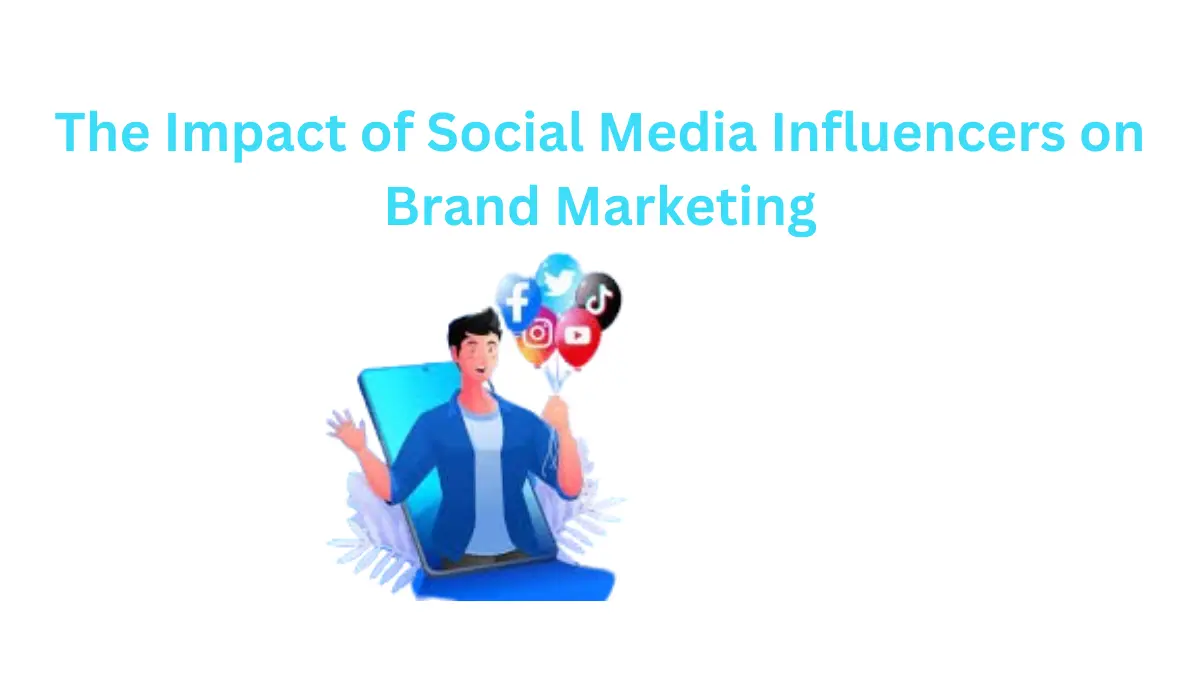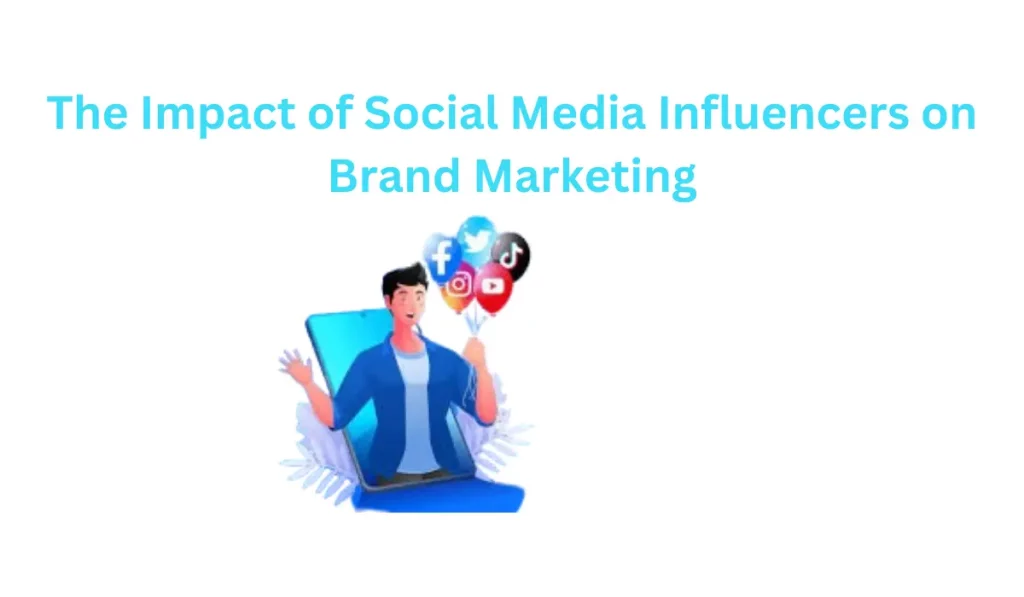Social media influencers have become integral partners in brand marketing strategies, offering unparalleled opportunities to connect with target audiences authentically. By leveraging the influence and creativity of influencers, brands can amplify their messaging, drive engagement, and cultivate meaningful relationships with consumers. In this context, we focus on the impact of social media influencers on brand marketing.
Let’s jump into the deep:
The Impact of Social Media Influencers on Brand Marketing
However, success in influencer marketing requires careful planning, strategic partnerships, and a commitment to authenticity and transparency. As the digital landscape continues to evolve, brands must adapt and innovate their influencer marketing approaches to stay relevant and impactful in the ever-changing world of social media.
The Rise of Social Media Influencers:
In the dynamic realm of social media, a new breed of content creators has emerged: social media influencers. These individuals have revolutionized the way brands engage with consumers and transformed the digital landscape.
The Birth of Influencer Culture:
The concept of influencers can be traced back to the early days of social media, when individuals began sharing their lives, interests, and expertise online. Platforms like YouTube, Instagram, and blogging sites provide a platform for ordinary people to showcase their talents, passions, and lifestyles. As these creators amassed followings and garnered attention, brands started taking notice of their ability to sway consumer behavior.
The Evolution of Influence:
What began as organic content creation gradually evolved into a sophisticated industry driven by influence and engagement. Influencers diversified their content, experimenting with different formats, topics, and styles to capture and retain audience attention. From beauty gurus to fitness enthusiasts, and travel bloggers to gaming streamers, influencers span a wide range of niches and demographics, catering to diverse audiences around the globe.
Influence as Currency:
In today’s digital economy, influence has become a valuable currency coveted by brands seeking to reach target consumers. Influencers possess the ability to shape consumer preferences, drive purchasing decisions, and amplify brand messaging with unparalleled authenticity and reach. As a result, influencer marketing has emerged as a cornerstone of brand promotion strategies, offering brands an effective means to connect with consumers in an increasingly fragmented media landscape.
Navigating the Influencer Ecosystem:
The influencer ecosystem is vast and diverse, encompassing creators of all sizes, from micro-influencers with niche audiences to mega-influencers with millions of followers. Brands must navigate this landscape carefully, identifying the right influencers whose values, audience demographics, and content align with their brand identity and marketing objectives. Successful partnerships hinge on mutual trust, transparency, and a shared vision for collaboration.
The Future of Influence:
As social media continues to evolve, so too will the role of influencers in shaping consumer culture and brand marketing strategies. With emerging platforms, technologies, and trends, influencers will adapt and innovate their content to stay relevant and engage audiences in new and exciting ways. The future of influence lies in authenticity, creativity, and the ability to foster genuine connections in an increasingly digital world.
Why Influencers Matter to Brands:
Influencers offer brands a unique opportunity to connect with consumers in an authentic and engaging way, ultimately driving brand awareness, trust, and sales.
Influencers matter to brands for several reasons:
Audience Reach: Influencers often have large and engaged followings on social media platforms, which allows brands to reach a wide and targeted audience.
Trust and Authenticity: Influencers have built trust with their followers over time through consistent content and engagement. When influencers recommend or endorse a product, their followers are more likely to trust the recommendation, leading to increased credibility and authenticity for the brand.
Targeted Marketing: Influencers often specialize in specific niches or demographics. Brands can leverage influencers who align with their target audience to ensure that their marketing efforts are reaching the right people.
Content Creation: Influencers are skilled content creators who know how to create engaging and visually appealing content. Brands can collaborate with influencers to create content that showcases their products or services in a way that resonates with their audience.
Social Proof: When influencers use and endorse a product, it provides social proof to their followers that the product is worth trying. This can lead to increased interest and sales for the brand.
Increased Engagement: Collaborating with influencers can lead to increased engagement with the brand’s social media channels. Followers may interact with the brand’s content more actively, leading to higher visibility and awareness.
Cost-Effective Marketing: Compared to traditional advertising channels, influencer marketing can be more cost-effective, especially for smaller brands. Instead of spending large sums on advertising, brands can allocate their marketing budgets towards collaborating with influencers who can deliver targeted and impactful campaigns.
The Power of Authenticity and Trust:
Authenticity and trust are essential elements of successful branding and marketing strategies. Brands that prioritize these values cultivate deeper connections with consumers, foster loyalty, and ultimately drive sustainable business growth.
The power of authenticity and trust cannot be overstated in today’s highly competitive and digitally-driven marketplace. Here’s why they are so crucial:
Building Strong Relationships:
Authenticity and trust are the cornerstones of building strong, long-lasting relationships with customers. When customers perceive a brand as authentic and trustworthy, they are more likely to develop a sense of loyalty and commitment.
Enhancing Brand Reputation:
Brands that consistently demonstrate authenticity and transparency in their actions and communications tend to enjoy a positive reputation among consumers. This positive reputation can serve as a competitive advantage, attracting new customers and retaining existing ones.
Fostering Emotional Connections:
Authenticity evokes genuine emotions and connections with consumers. When consumers feel a genuine connection with a brand, they are more likely to engage with its content, advocate for it, and remain loyal over time.
Increasing Customer Loyalty:
Trust is a fundamental factor in building customer loyalty. When customers trust a brand, they are more likely to repeat purchases, recommend the brand to others, and forgive occasional mistakes or shortcomings.
Driving Purchase Decisions:
Authenticity and trust play a significant role in influencing consumer purchase decisions. Consumers are more inclined to choose brands they perceive as authentic and trustworthy, even if they have other options available.
Creating Brand Advocates:
Authentic brands with a strong foundation of trust often cultivate passionate brand advocates. These advocates willingly promote the brand to their networks, serving as valuable ambassadors and amplifying the brand’s message.
Navigating Crises Effectively:
Brands that have established trust and authenticity prior to a crisis are better equipped to navigate challenging situations. During crises, transparent communication and genuine concern for customers can help maintain trust and mitigate reputational damage.
Differentiating From Competitors:
In crowded markets, authenticity and trust can serve as key differentiators. Brands that prioritize these values stand out from competitors and attract consumers seeking genuine connections and experiences.
Types of Influencer Partnerships:
Brands can effectively reach and engage their target audience, drive brand awareness, and achieve their marketing objectives credibly and authentically through influencer partnerships.
It comes in various forms, tailored to meet specific campaign goals, target audiences, and brand objectives. Here are some common types of influencer partnerships:
Sponsored Content:
In this type of partnership, brands pay influencers to create and share content featuring their products or services. This could include Instagram posts, YouTube videos, blog posts, or tweets, among others. The content is typically labeled as “sponsored” or “paid partnership” to ensure transparency with the audience.
Affiliate Marketing:
Affiliate partnerships involve influencers promoting a brand’s products or services through unique tracking links or discount codes. Influencers earn a commission or a flat fee for every sale or conversion generated through their referral link. This model incentivizes influencers to drive sales while providing measurable ROI for the brand.
Brand Ambassadorships:
Brand ambassador partnerships involve a longer-term collaboration between a brand and an influencer. Ambassadors are often selected based on their alignment with the brand’s values, target audience, and content style. They represent the brand over an extended period, creating content, attending events, and engaging with their audience to build brand awareness and loyalty.
Product Reviews and Unboxing:
Brands may partner with influencers to review their products or unbox them on camera. This type of partnership allows influencers to provide authentic feedback and showcase the product’s features, benefits, and usage. Product reviews can help build trust with the audience and drive purchase consideration.
Giveaways and Contests:
Brands may collaborate with influencers to host giveaways or contests, where followers can participate for a chance to win prizes. Influencers typically promote the giveaway on their social media channels, encouraging their audience to enter by following the brand, liking the post, or tagging friends. Giveaways can increase brand visibility, engagement, and follower growth.
Event Collaborations:
Brands may partner with influencers to host or attend events, such as product launches, store openings, or sponsored gatherings. Influencers may share their experience at the event through social media posts, stories, or vlogs, amplifying the brand’s reach and creating buzz among their followers.
Content Co-Creation:
Brands and influencers collaborate to co-create content, such as sponsored videos, blog posts, or Instagram campaigns. This collaborative approach allows brands to leverage the influencer’s creativity, expertise, and audience insights to develop engaging and authentic content that resonates with their target audience.
Social Media Takeovers:
Brands may invite influencers to take over their social media accounts for a limited time to create and share content directly with the brand’s audience. Takeovers can bring fresh perspectives, increase engagement, and attract new followers to the brand’s social channels.
Also Read
Measuring the Impact of Influencer Marketing:
Measuring the impact of influencer marketing is essential for evaluating the effectiveness of campaigns, optimizing strategies, and demonstrating ROI to stakeholders. Here are several methods commonly used to measure the impact of influencer marketing:
Engagement Metrics:
Engagement metrics, such as likes, comments, shares, and clicks, provide insights into how audiences are interacting with influencer content. Higher engagement rates indicate that the content is resonating with the audience and driving interest in the brand or product.
Reach and Impressions:
Tracking the reach and impressions of influencer content helps determine the size of the audience exposed to the brand message. This data is valuable for understanding the campaign’s overall visibility and potential reach within the target market.
Follower Growth:
Monitoring changes in the influencer’s follower count before, during, and after the campaign can indicate the campaign’s impact on audience growth. A significant increase in followers during the campaign period suggests that the content attracted new followers to the influencer’s profile.
Website Traffic and Conversions:
Analyzing website traffic and conversion metrics, such as clicks, website visits, and conversions (e.g., purchases, sign-ups), attributed to influencer-generated content provides insights into the campaign’s effectiveness in driving traffic and sales.
Sales and Revenue:
Tracking sales and revenue directly attributable to influencer marketing efforts helps quantify the campaign’s impact on business outcomes. This can be achieved through unique tracking links, promo codes, or other attribution methods tied to influencer content.
Brand Mentions and Sentiment Analysis:
Monitoring brand mentions and sentiment on social media platforms and other online channels can gauge the impact of influencer content on brand perception. Positive sentiment and increased mentions may indicate a successful campaign.
Audience Feedback and Surveys:
Collecting feedback from the influencer’s audience through surveys or direct engagement can provide qualitative insights into their perception of the brand, product, or campaign. This feedback can help refine future influencer strategies and messaging.
Return on Investment (ROI):
Calculating the ROI of influencer marketing involves comparing the campaign’s costs (e.g., influencer fees, production costs) with the generated revenue or other measurable outcomes (e.g., increased brand awareness, and customer acquisition). ROI analysis helps determine the campaign’s profitability and efficiency.
Long-term Brand Metrics:
Assessing long-term brand metrics, such as brand awareness, brand perception, and customer loyalty, can help evaluate the sustained impact of influencer marketing beyond immediate campaign results.
Also Read
Challenges and Considerations for Brands:
Brands face several challenges and considerations when implementing influencer marketing campaigns. These include:
Finding the Right Influencers:
Identifying influencers who align with the brand’s values, target audience, and campaign objectives can be challenging. Brands must carefully research and vet potential influencers to ensure they are a good fit for the partnership.
Authenticity and Trust:
Maintaining authenticity and trust in influencer partnerships is essential for building credibility with the audience. Brands should collaborate with influencers who genuinely believe in their products or services and are transparent with their followers about sponsored content.
Ensuring Compliance and Disclosure:
Adhering to regulatory requirements and guidelines, such as FTC regulations in the United States, regarding disclosure of sponsored content is crucial. Brands must ensure that influencers clearly disclose their relationship with the brand to their audience to maintain transparency and trust.
Setting Clear Expectations:
Establishing clear expectations and guidelines for influencer partnerships is essential for ensuring alignment and consistency with the brand’s messaging and objectives. Brands should communicate their expectations regarding content, messaging, brand guidelines, and performance metrics upfront.
Managing Relationships:
Cultivating and maintaining positive relationships with influencers requires ongoing communication, collaboration, and support. Brands should invest time and effort in nurturing these relationships to foster mutual trust and long-term partnerships.
Measuring ROI and Effectiveness:
Measuring the ROI and effectiveness of influencer marketing campaigns can be complex due to various factors influencing performance. Brands must define clear KPIs, implement tracking mechanisms, and analyze data to evaluate the impact of influencer partnerships accurately.
Budget Allocation and Resource Management:
Allocating sufficient budget and resources for influencer marketing initiatives is critical for achieving desired outcomes. Brands should carefully assess their budget constraints, allocate resources effectively, and prioritize investments based on campaign objectives and expected returns.
Monitoring and Mitigating Risks:
Influencer marketing campaigns may pose certain risks, such as negative publicity, brand misalignment, or influencer misconduct. Brands should implement risk management strategies, monitor campaign performance closely, and respond promptly to any issues or concerns arise.
Adapting to Changing Trends and Platforms:
The landscape of influencer marketing is continually evolving, with new trends, platforms, and technologies emerging regularly. Brands must stay informed about industry developments, adapt to changing trends, and explore innovative approaches to remain competitive and relevant.
End Words
In conclusion, the impact of social media influencers on brand marketing strategies offers unparalleled opportunities to connect with target audiences authentically. By leveraging the influence and creativity of influencers, brands can amplify their messaging, drive engagement, and cultivate meaningful relationships with consumers. However, success in influencer marketing requires careful planning, strategic partnerships, and a commitment to authenticity and transparency. As the digital landscape continues to evolve, brands must adapt and innovate their influencer marketing approaches to stay relevant and impactful in the ever-changing world of social media.







